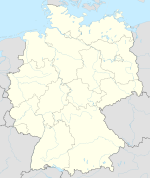Campus Galli
| Campus Galli | |
|---|---|

Carpenter's hut at Campus Galli
|
|
|
Campus Galli in Germany
|
|
| General information | |
| Coordinates | 48°02′01″N 9°06′32″E / 48.033533°N 9.108905°ECoordinates: 48°02′01″N 9°06′32″E / 48.033533°N 9.108905°E |
| Construction started | 2013 |
Campus Galli is a Carolingian monastic community under construction in Meßkirch, Baden-Württemberg, Germany. The construction project includes plans to build a medieval monastery according to the early ninth-century Plan of Saint Gall using techniques from that era. The long-term financing of the project is to come from revenue generated from the site's operation as a tourist attraction. The construction site has been open for visitors since June 2013.
The Carolingian monastery town is being constructed in a wooded area approximately four kilometers north of the small town of Meßkirch in southern Germany. The buildings are being built according to the Plan of Saint Gall, which is the only surviving major architectural drawing from the middle-ages. The construction of the monastery town will be accomplished as much as possible with the materials and methods of the time of Charlemagne in keeping with goals of Experimental archaeology, thereby increasing our scientific knowledge of Carolingian architecture and engineering. The major raw materials, such as wood and stone, will be obtained from the site.
Between 20 and 30 staff members will be permanently at the site, with an exception according to the Medieval custom for resting during the winter months from November 11 (St. Martin's day) until April 2 (Charlemagne's birthday). The total construction time is estimated at forty years. Volunteer workers not only help with the construction, but also act as costumed interpreters.
The project was launched by the Aachen-based journalist Bert Geurten with 1 million euros provided by city, state and European-Union sources. An Advisory Board of 18 experts in fields including archaeology, history, theology, and veterinary medicine will provide the scientific management and monitoring of the construction.
A small area in the forest was cleared by the end of June 2013, and temporary shelters for the craftsmen were built. A map of the site shows areas for carpenters, basket weavers, potters, blacksmiths, stonemasons, wood turners, broom makers, roofers, textile workers, and rope makers. There are also pens for pigs, goats and sheep, and a chicken coop, along with a bee hive. There is a herb garden for healer's plants. In the center of the site is the ongoing construction of a wooden church.
...
Wikipedia

